Country of origin of butter and cheddar sold in Scottish and British retailers: analysis
The number of Scottish added value dairy products sold across Scotland and GB were evaluated.
2. Analysis
All analysis carried out by Scotland Food & Drink from data provided by Kantar Worldpanel, detailed tables and data available on request.
2.1 Butter
The butter definition for the purposes of this analysis includes block butter and spreads in all formats, including spreadable butter blends. The core analysis does include margarine and dairy substitute spreads.
2.1.1 Butter executive summary
The total GB Butter market is worth an estimated £718m, a 1.5% rise compared to last year, this has been driven by a volume increase of 8.7% to over 160,000kg whilst the average cost per kg has dropped by 6.7% to £4.47kg in retail.
Across total GB, the average household has purchased 7.85kg a year, this compares to a Scottish figure of almost 9kg over the same period. Total spend for butter in Scotland is £87m.
Across total GB, 2% of all butter volume sold is of Scottish origin, with 45% being of UK/GB origin and 34% Danish.
Across Scotland, 14% of all butter volume is of Scottish origin, with 51.6% Danish and 21% of UK or GB origin.
Across total GB, 69% of the market volume is branded, this rises to 77% in Scotland. This is split out below for key origins, in particular Danish branded butter stands out.
| Total Butter | Private Label | Branded | ||||
|---|---|---|---|---|---|---|
| Origin | GB | Scot | GB | Scot | GB | Scot |
| Scotland | 2% | 14% | 4.2% | 37.8% | 1% | 7.2% |
| UK or GB | 45% | 21% | 6% | 28.6% | 36.9% | 19% |
| Denmark | 34% | 51.6% | 0.2% | 0.3% | 49.5% | 65.5% |
In a SKU analysis carried out on products sold in retailers over the past 52 weeks it was found that that almost 12% of SKUs stocked in Scottish retailers were Scottish. When looking at the rest of GB excluding Scotland this figure was 4%.
Looking specifically at private label products in Scottish stores, 13.5% of butter SKUs were Scottish with most retailers having a private label Scottish butter SKU, all these SKUs were restricted to block butters. The majority of private label spreadable products were either of Irish origin or unclear.
The only retailers currently not to have a private label Scottish butter were Waitrose and Morrisons. Waitrose did have a good range of Scottish branded butter and Morrisons appeared to have had one in the past 52 weeks stocked but sales appear to have almost entirely halted.
For branded butter products in Scottish stores the figure was 11.5%, all retailers had a presence of Scottish butter brands across both block and spreadable variants. The main Scottish origin brands captured were Graham's and Lockerbie butters.
Currently 99.6% of Scottish origin branded butter products are sold in Scotland, only 0.04% is sold in the rest of GB.
2.1.2 Butter labelling
Butter labelling was varied across private label SKUs, all major retailers, with the exception of Morrisons and Waitrose had a Scottish private label butter SKU. It would be considered justifiable for Waitrose, with less than a 1.5% market share in Scotland to not have a Scottish SKU. Morrisons appears to have at one stage had a Scottish private label SKU but was not available at the time of analysis and had no recorded sales in the past 12 years, for a retailer with over 12% in Scotland, this is surprising.
Of the retailers that did have a Scottish butter SKU, examples have been included below of the packs:
Tesco Scottish Salted Butter - produced in Scotland using Scottish milk

JS Scottish Salted Butter - produced and packed in Scotland using Scottish milk

Aldi Brodies Scottish Salted butter - produced in Scotland using Scottish milk

Lidl Scottish Salted Butter - produced in Scotland using British milk
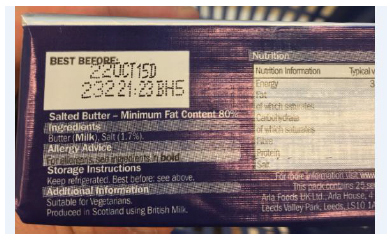
M&S Scottish Salted Butter - made in Scotland, churned using Scottish milk from the Lockerbie creamery

Asda Scottish Salted Butter - produced in Scotland
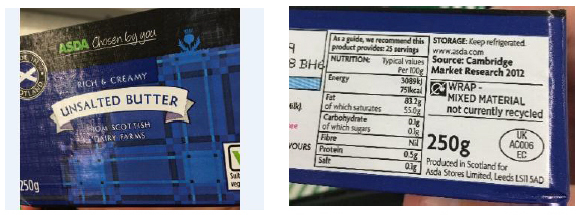
In terms of spreadable butter, many retailers appeared to be producing similar products to offer an alternative to the Danish branded market leader. Many of these are branded to suggest they are of Danish origin, when in fact they are Irish, this is the case with a large number of the spreadable butter products where the origin of the milk is unclear, some examples are below, all the major multiples have comparable products but often these contain less than 25% pure butter.
Aldi Norpak
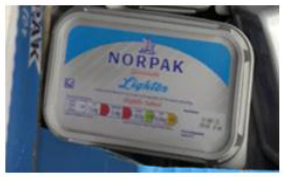
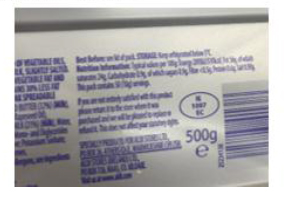
Tesco Butterpak
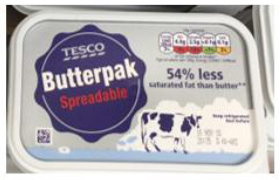
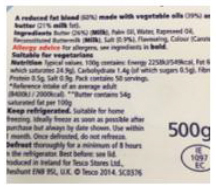
JS buttersoft
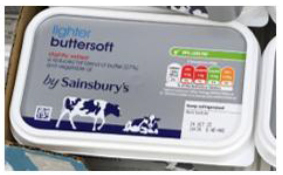
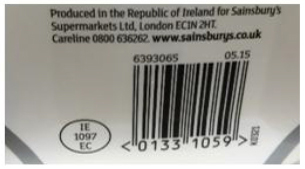
2.1.3 Butter market value - GB
The total butter retail take home market is growing in volume terms by 8.7% across GB to over 160,000 tonnes sold last year. The price of this has dropped by 6.7% to mean total spend in the butter sector is up 1.5%. The above KPI table represents where the total value comes from, one of the key figures is penetration, a measure showing percentage of the GB population buying butter in the past year, the figure grew last year by over 2% to over 76% of GB households buying butter.
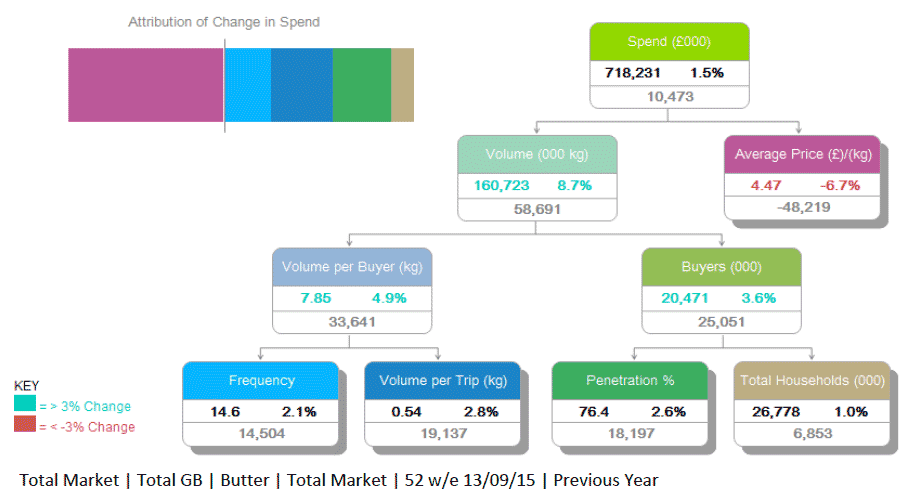
In Scotland, the figure is slightly lower in terms of growth rate, at only 0.9%, but in Scotland shoppers on average buy more butter each year, buying 9kg a year, over a kg more than the average British shopper. The total butter market in Scotland is just over £87m with the growth in volume per shopper of 5%.
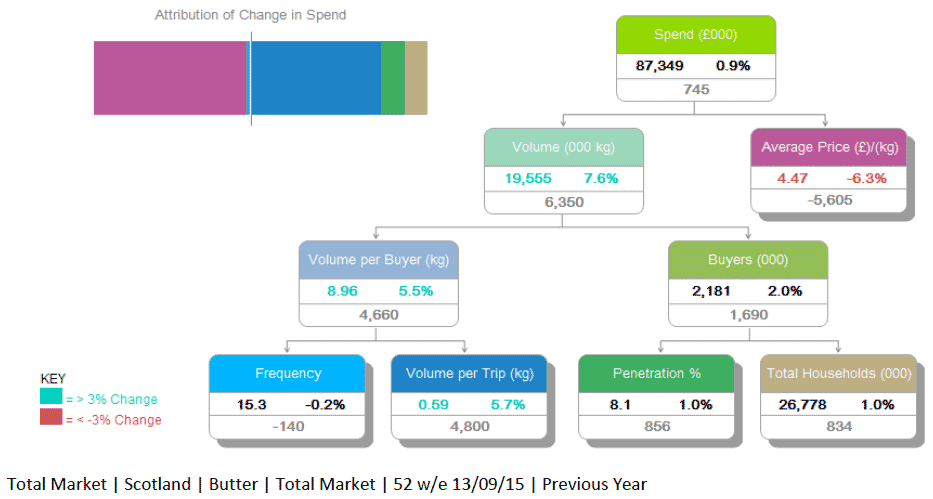
This rise appears to have come due to the fact spreads and margarines have declined, with butter making up almost 65% of the spread category, growing over the past three years steadily as the below chart represents. In total GB, the split is much closer, with approximately 55% of the market being butter.
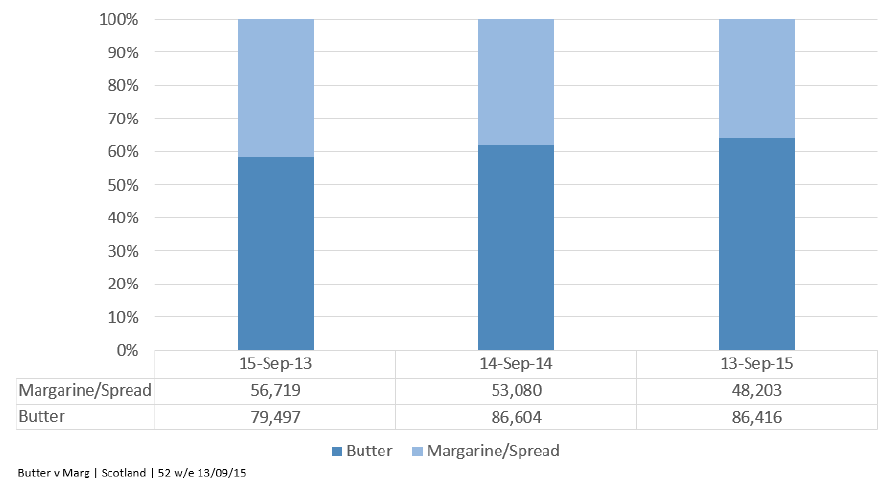
In Scotland also we are much more likely to purchase brands, a trend recognised across most food and drink categories. In Scotland over 80% of butter value is in brands, this compares to 73% across GB.
| VALUE | Total GB | Total Scotland) | Total GB exc. Scotland | |||
|---|---|---|---|---|---|---|
| Total Market | £718,231 | £87,349 | £630,882 | |||
| Private Label | £188,486 | 26.2% | £16,644 | 19.1% | £171,842 | 27.2% |
| Branded | £529,745 | 73.8% | £70,705 | 80.9% | £459,041 | 72.8% |
2.1.4 Origin value
The value of Scottish origin private label butter is up 63% in value terms over the past year, this can be attributed to greater distribution of private label butter by the retailer and better sourcing, particularly in the discounters which have had considerable market growth over the past year. With its reduced SKU range the Scottish block butter is one of the few options to consumer. In terms of branded butter, Scottish origin butter has struggled with a slight decline across GB, of this Scottish branded butter, less than 0.1% is sold out with Scotland, whilst in the same period, Danish branded products are up 5% in value terms, worth over £271m.
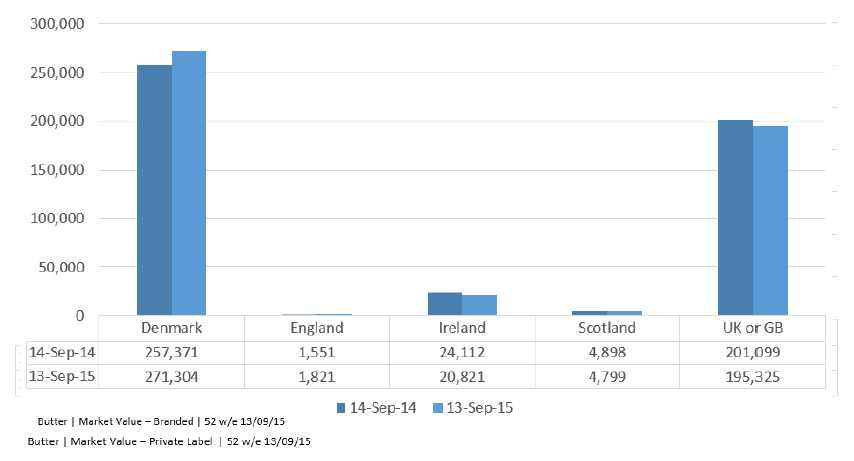
In Scotland we can see that British brands outsell Scottish brands by more than two to one, whilst Danish brands outsell Scottish brands by ten to one.
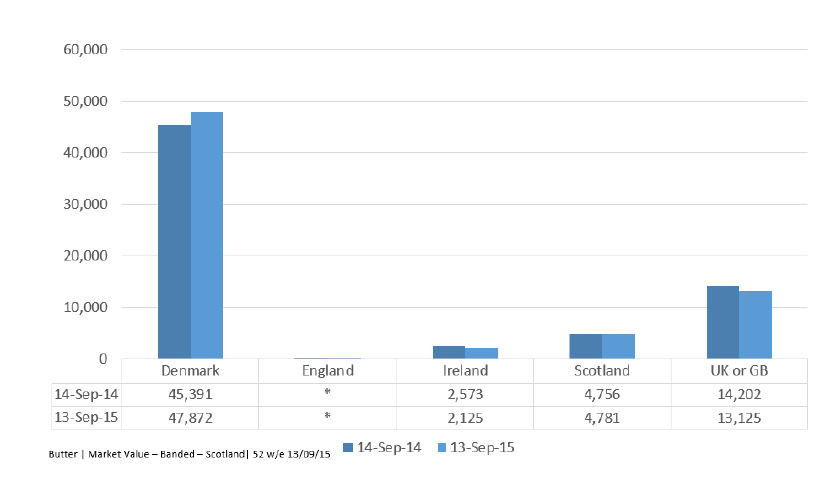
Overall whilst the total butter market is in growth, it is clear the majority of this growth is coming from one origin and one brand, the Danish Lurpak brand.
2.1.5 Retailer origin % breakdowns
All butter
At a total level across GB almost 2% of butter sold is Scottish in value terms. At a Scottish level all perform well with the exception of Morrisons and Waitrose, the stand out performers are the discounters, particularly Aldi, with 10% of its butter value being Scottish.
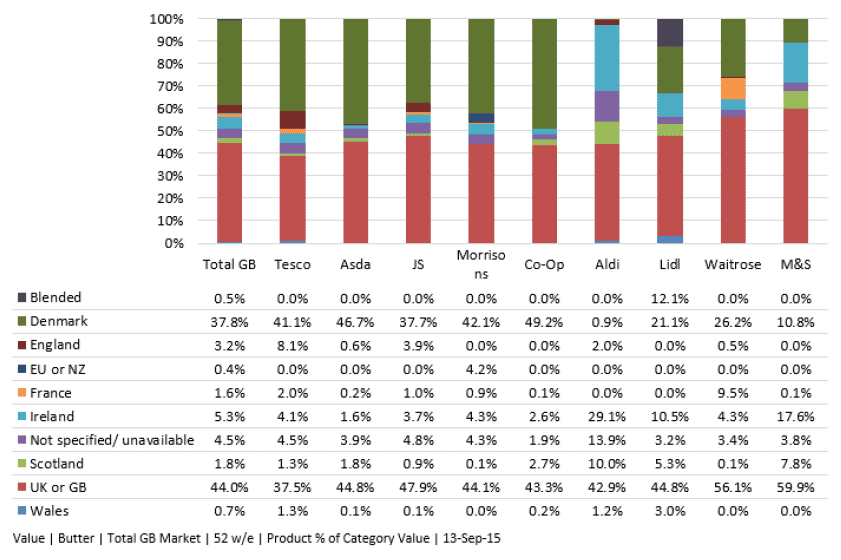
The two major origins were GB and Denmark, making up over 80% of the market, followed by Ireland with 5%. This figure is skewed by Lurpak, which accounts for almost all of the Danish origin sales. Later charts break out private label separately.
At a Scottish level the figure rises to almost 13% of total sales being of Scottish origin with retailers performing generally well, in particular the discounters, Sainsbury's, Co-op and M&S. Only 0.4% of Morrisons butter sold in Scotland was of Scottish origin over the past year whilst almost 50% of Aldi's was in the same period.
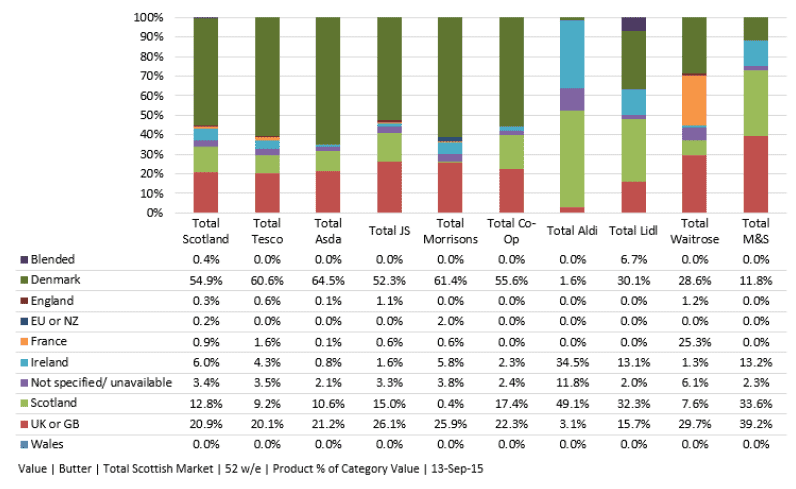
In terms of SKUs, most retailers had a good percentage of Scottish SKUs, with 12% being the average, this shows that shoppers did have choice of Scottish products available to purchase.
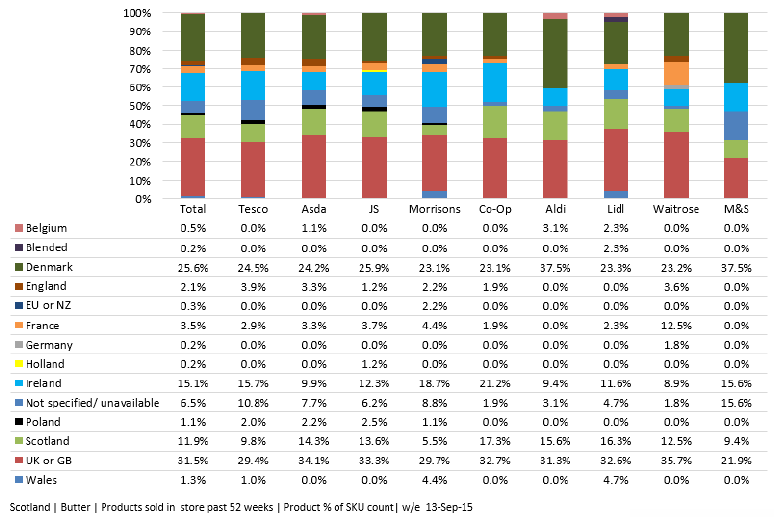
Private label butter
Almost 40% of private label butter sold in retailers in the past year has been of Scottish origin. Asda, Sainsbury's, Co-op and Aldi are the strongest performers, whilst Waitrose and Morrisons have no private label, Scottish origin butter. In the rest of GB only 0.8% of private butter value is Scottish.
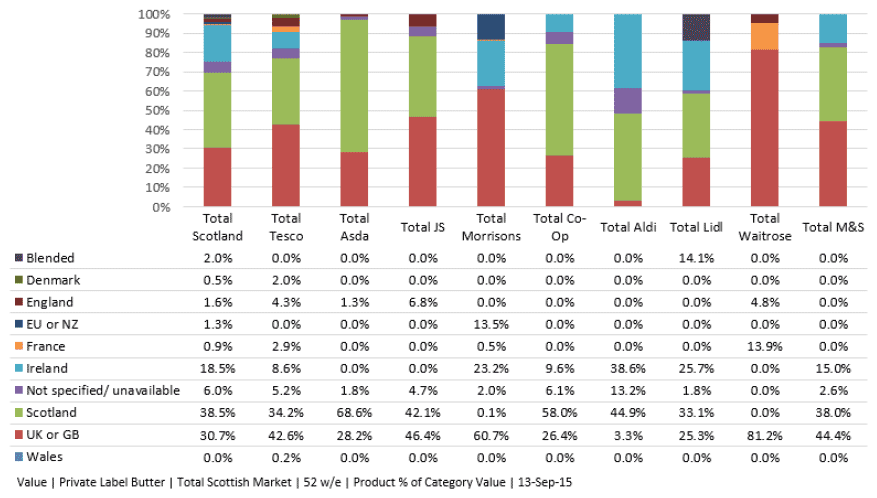
Branded butter
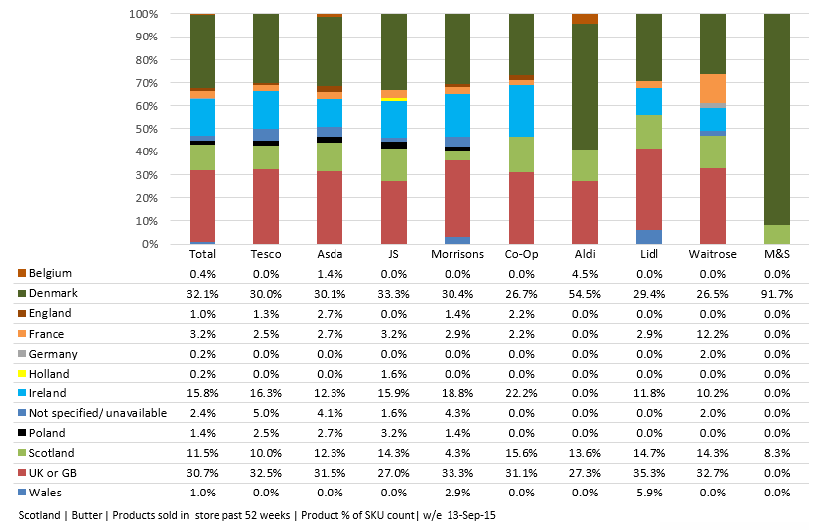
In Scotland, the above chart represents the dominance that the Lurpak brand has in Scotland, £2 out of every £3 spent on branded butter goes on the Danish brand, whilst only 7% of Scottish butter spend is spent on Scottish brands.
This lack of spend cannot be attributed to the retailers lack of stocking Scottish brands, the analysis shows that over 11% of SKUs stocked were Scottish.
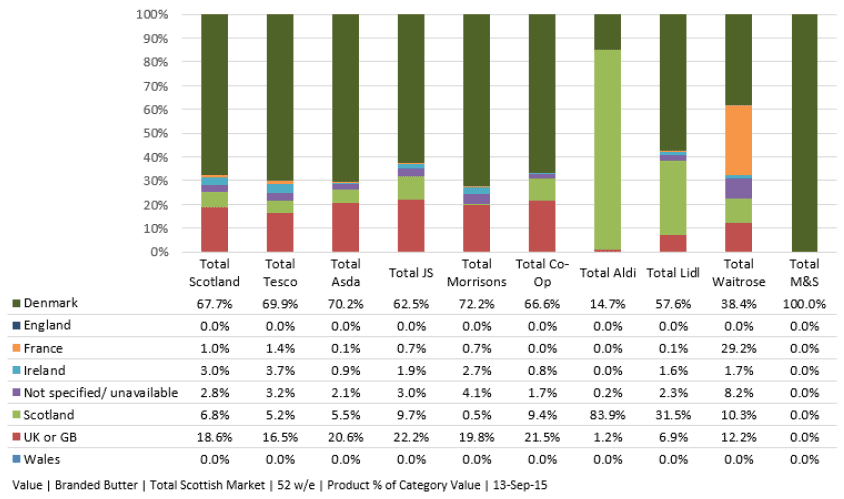
At store, retailers were merchandising Scottish brands well in fixture, gaining prime eye level facings in retailers. Brands such as Lurpak and Anchor are gaining volume through merchandising by investing in promotional space on the end of aisles.
Waitrose Comely Bank
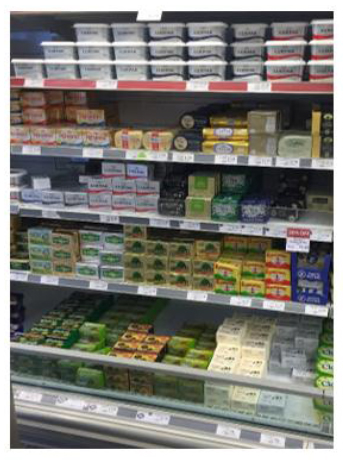
Sainsbury's Blackhall
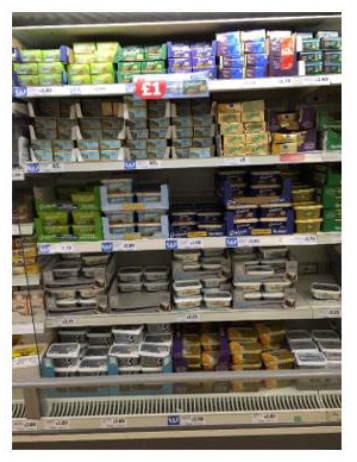
Asda Leith
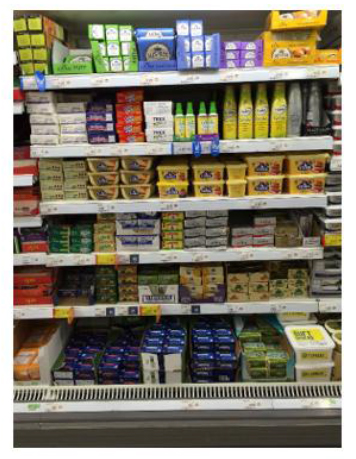
2.2 Cheddar
2.2.1 Cheddar executive summary
The total GB cheddar market is worth almost £1.43bn, this has suffered a decline in value of 4.7% over the past year despite a volume increase of 0.6%. The primary driver for the decline has been a drop in average price per kg of over 5% to £6.30.
In Scotland the decline has been larger, 6.6% due to a decrease in volume of almost 1% to 20 million kg with a value of £125.8m. In Scotland less cheddar is bought per a household, buying just over 7.5kg, almost a 1% year on year decline compared to 8.9kg for total GB.
Across GB, 5.6% of all cheddar volume sold is of Scottish origin, with almost 75% from UK or GB, 6.7% Irish and 6.3% from a mixture of UK, IRE, NZ and AUS.
In Scotland almost 27% of cheddar volume is Scottish, whilst 57% is from UK or GB, 5.1% from Ireland and almost 6% from UK, IRE, NZ and AUS.
Almost 38% of cheddar volume sold across GB is branded whilst for Scotland this figure rises to over 43%. A breakdown of key origins and regions is in the table below:
| Origin | Total Cheddar | Private Label | Branded | |||
|---|---|---|---|---|---|---|
| GB | Scot | GB | Scot | GB | Scot | |
| Scotland | 5.6% | 27% | 4% | 31.7% | 8.2% | 20.3% |
| UK or GB | 75% | 57% | 77.2% | 52.8% | 70.6% | 62.7% |
| Ireland | 6.7% | 5.1% | 10.1% | 8.3% | 1% | 1% |
| UK, IRE, NZ, AUS | 6.3% | 6% | 0% | 0% | 16.6% | 13.6% |
Irish cheese has a considerable amount of the private label market compared to butter, particularly at the value end of the market. As well as this, there is much more mixed origin cheddars in both brands and private label.
SKUs by retailers is much more varied in the cheddar market, with regional British cheddars stocked heavily across GB and Scotland. In the vast majority of cases, non-Scottish, British regional cheeses had their origin marked as being of GB or UK origin with the exception of PGI and PDO types.
2.2.2 Cheddar labelling
Private label Scottish cheddar, like butter had mixed results from retailers in terms of detail. This ranged from express milk and production origin, to just a saltire to represent the product being Scottish. Due to the distinct nature of Scottish cheddar in being its own style, all the major retailers have private label Scottish cheddars.
Below are examples of the packaging labelling from some of the major retailers' core Scottish cheddar ranges:
Tesco Scottish Cheese, Mature Scottish Cheddar - produced in Scotland using Scottish milk

Sainsbury's Scottish Mature Coloured Cheddar - produced in Scotland and packed in the UK using British milk

Lidl Valley Spire Scottish Medium Coloured Cheddar - produced in Scotland and packed in the UK using UK milk

Morrisons Scottish Mild Cheddar - produced in Scotland from British milk
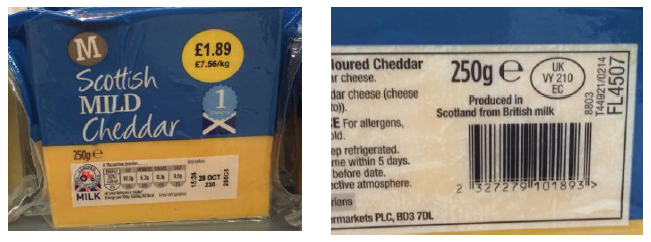
Aldi Glen Lochy Mature Cheddar- no declaration other than processor code but did have a 'produced in Scotland' logo
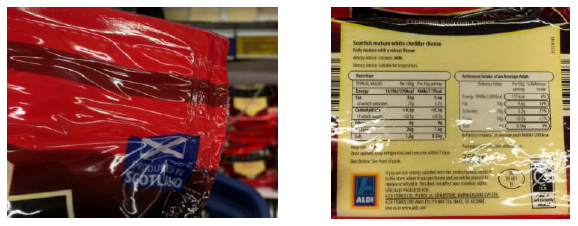
2.2.3 Cheddar packing and added-value processing
In the Scottish cheddar market there is a trend of the cheese being produced in Scotland but then packaged in the UK. This trend appears in some private label SKUs, and goes further to Scottish brands. Scottish brands in most cases are very forth coming about this and express it expressly on its packaging, as noted with Graham's cheddar.
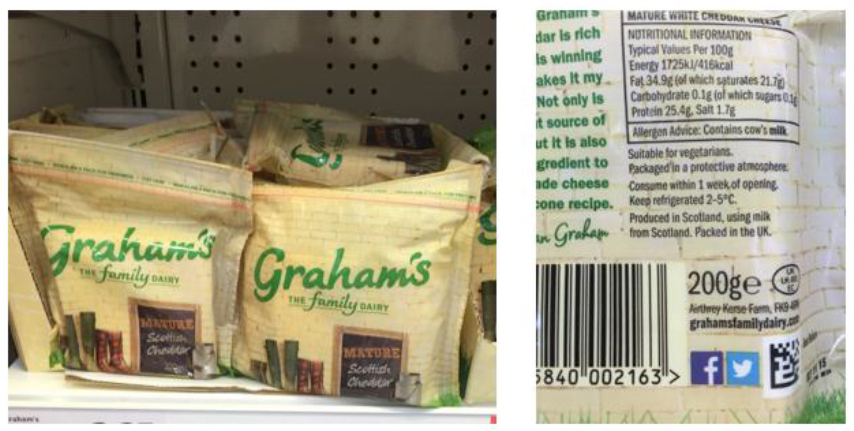
There were examples of Scottish brands where block cheddar was produced and packaged in Scotland, but sliced and grated SKUs of the same brands were packaged in the UK. This suggests that there is a gap in Scotland for packing, slicing and grating facilities for processors of both branded and private label cheddar.
In extreme cases it was noted that brands with origins from other parts of the UK were trying to replicate the success of Scottish cheddars. Collier's, a well-known Welsh brand is currently trialling a Scottish cheddar, produced in Scotland with Scottish milk and packaged in England.
Galloway block
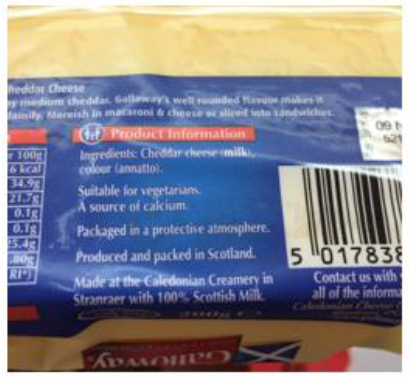
Galloway sliced
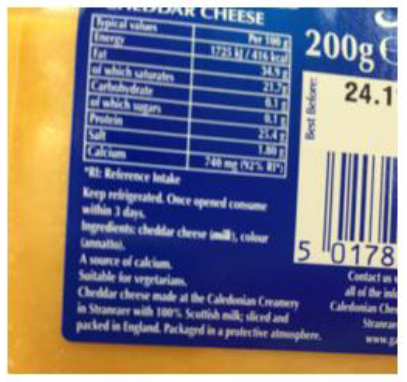
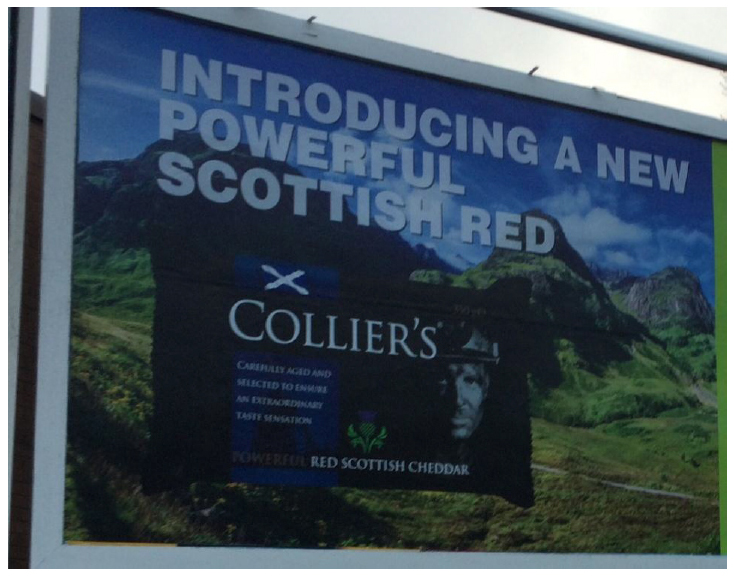
2.2.4 Cheddar market value
The retail take-home cheddar market is significantly larger than the butter market, estimated to be worth over £1.42bn in annual sales across GB. Volume sales are relatively flat, up by only 0.5% over the past year. Despite volumes being flat, the value is down by over £70m, driven entirely by average prices being down by over 5%.
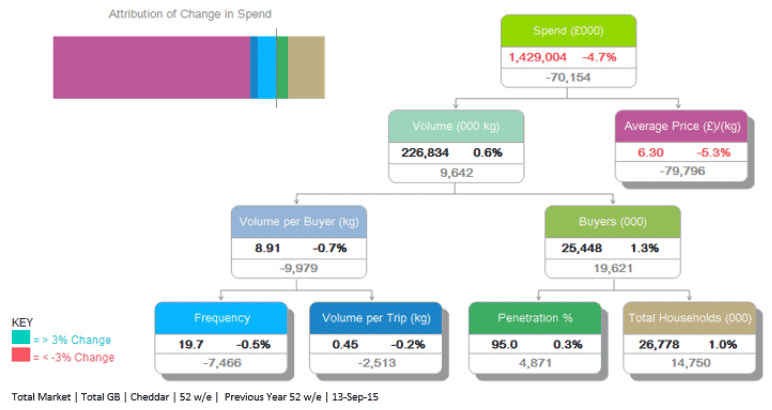
In Scotland, the market is smaller due the fact we buy almost 1.5kg less cheddar than the GB average. This, coupled with a similar drop in average price per kg means the market in Scotland is declining at a rate of over 6.5% in value terms. Last year there was an estimated £9m wiped of the cheddar retail market due drop in price per kg to leave the market at just under £126m.
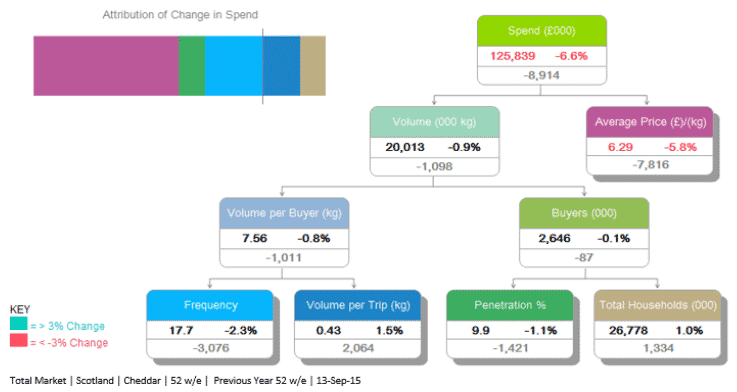
Private label/branded split
The cheddar market has a much higher private label presence than the butter market, with it accounting for almost 60% of market value across GB. Scotland follows the same trend of butter and other categories of being made up of more brand focused consumers, in Scotland private label makes up closer to 50% of the total market.
| VALUE | Total GB (£000) | Total Scotland (£000) | Total GB exc. Scotland (£000) | |||
|---|---|---|---|---|---|---|
| Total Market | £1,429,004 | £125,839 | £1,303,164 | |||
| Private Label | £836,921 | 58.6% | £66,312 | 52.7% | £770,609 | 59.1% |
| Branded | £592,083 | 41.4% | £59,527 | 47.3% | £532,556 | 40.9% |
2.2.5 Origin value
The total value of Scottish cheddar is estimated to be just under £82.5m, this has suffered a drop in the past year of 4% to just over £85.5m, primarily due to a drop in the value of branded. The private label market for Scottish produce has performed well in the period.
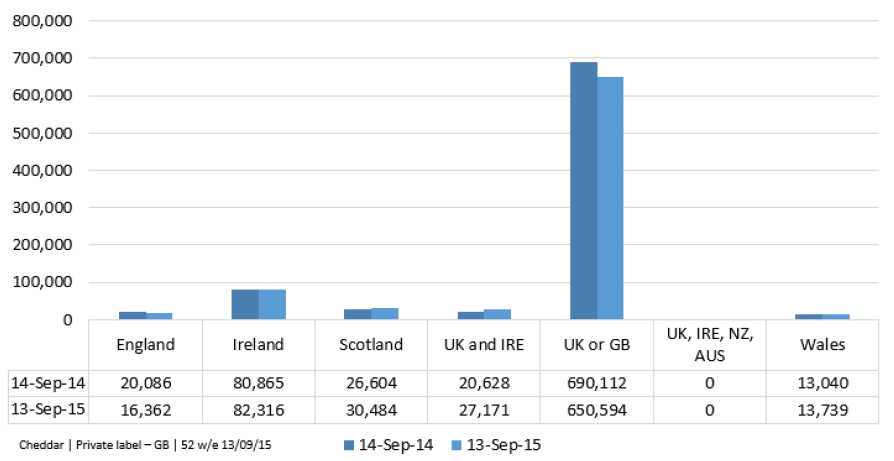
Scottish private label cheddar has grown in the GB market by 15% in the past year to be worth over £30m, approximately one third of this is sold in the rest of GB, outwith Scotland. Ireland accounts for just over 10% of the total private label market, almost double of Scottish origin share. It is noted thought that some Scottish origin cheddar may be labelled as UK or GB origin in retailers. The Irish private label cheddar opportunity is significant, being worth more than £80m.
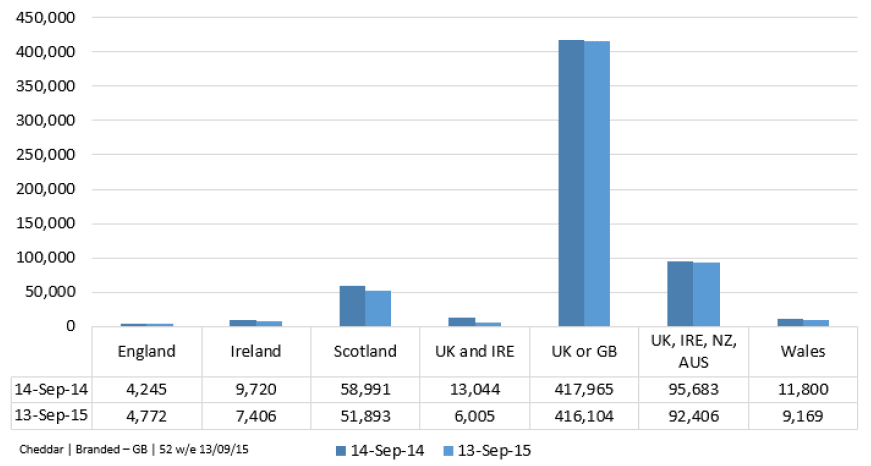
In branded origin sales, Scotland has traditionally had a strong hold of the market across GB, currently standing at almost £52m, in the past year due to aggressive promotions and the drop in cheddar prices it has declined by 15%. This is a trend seen across most of the major origins due to the competitive landscape.
Scottish origin branded cheddar is less much reliant on the Scottish market and almost 75% of its sales are made up from the rest of GB. The decline in the past year in the rest of GB has been at a faster rate than Scotland.
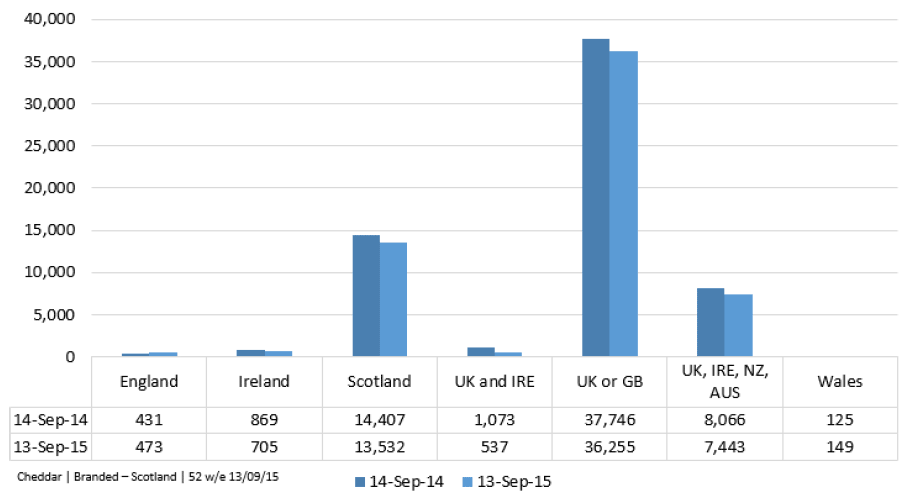
In Scotland, almost 25% of branded cheddar sold is Scottish, and 85% from the UK. Irish branded cheddar accounts for just over 1% of the market whilst Pligrims Choice mixed origin SKUs account for 13% of the market.
2.2.6 Retailer origin percentage breakdowns
Total GB market
Across GB, almost 6% of the total cheddar value is Scottish origin, whilst 75% is UK or GB which may contain some Scottish products. The majority of retailers perform well on this measure, particularly Aldi where over 17% of cheddar value is of Scottish origin. Irish cheddar makes up over 6% of the total GB market, with the majority of this coming from private label, value tier SKUs sold in Tesco.
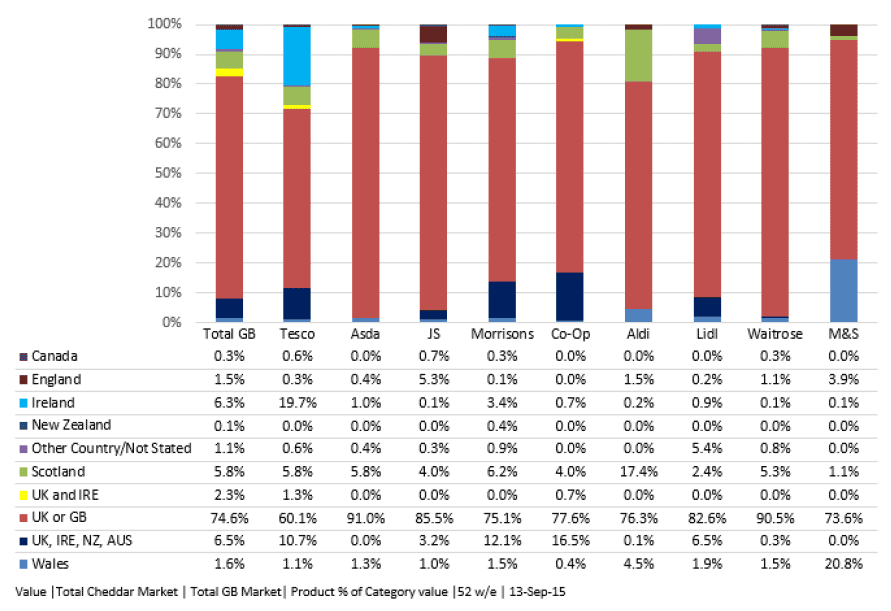
In Scottish retailers the amount of Scottish origin represents more than a quarter of the total market, with all retailers performing well with the exception of the higher end retailers. Aldi, Co-op, Sainsbury's and Aldi performed particularly well.
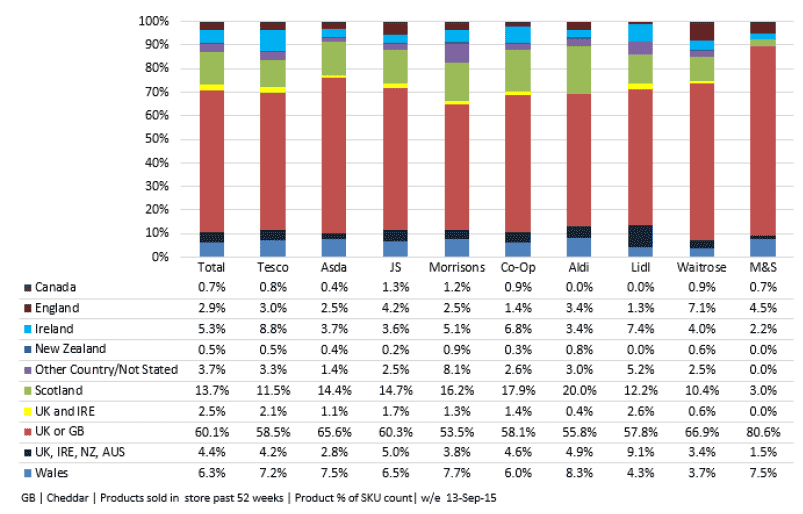
Focusing on SKU counts, Scotland slightly under indexes at 13.7%, this measure though does not take into account facings on shelf. It is also representative for the whole year where there will be a vast amount of seasonal and regional SKUs in the category which other categories such as butter will not encounter.
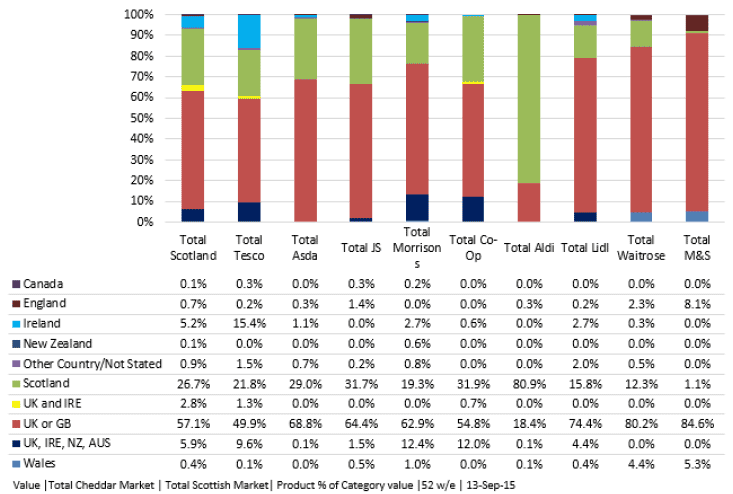
Private label cheddar
In Scotland, 30% of private label cheddar is Scottish, this is very variable dependent on retailer. The best performers are Aldi, Co-op and Asda which all post over 40% of products sold being Scottish. Tesco currently only has 17% of its private label cheddar being Scottish, this is in part due to the high volume of private label Irish cheddar, mainly in its value tier.
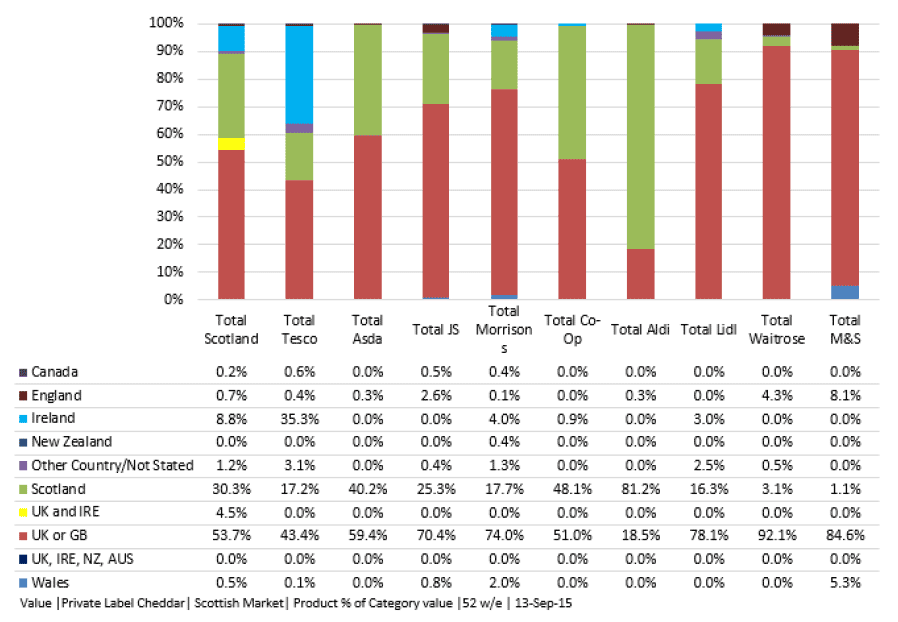
Branded cheddar
In Scotland the branded market is strong for Scottish cheddar, with almost 23% of value being Scottish. Over 60% of category value is of UK or GB origin, whilst the other major segment is a UK, IRE, NZ and AUS mixture, this is from some of the major Pilgrim Choice SKUs. Most retailers stock a good range and Tesco, Sainsbury's and Asda perform particularly well in this segment.
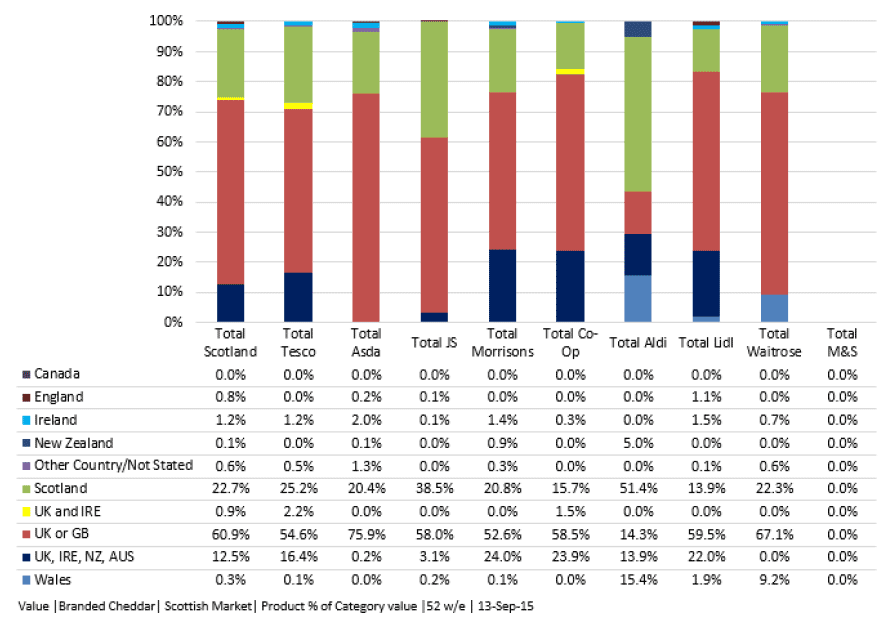
In terms of SKU counts of Scottish brands, retailers perform very well, with almost a quarter of branded SKUs in Scottish retailers being of Scottish origin. This will be bolstered by limited edition and seasonal SKUs. All retailers perform well against branded measures, with the exception of M&S which carries only a minimal branded range.
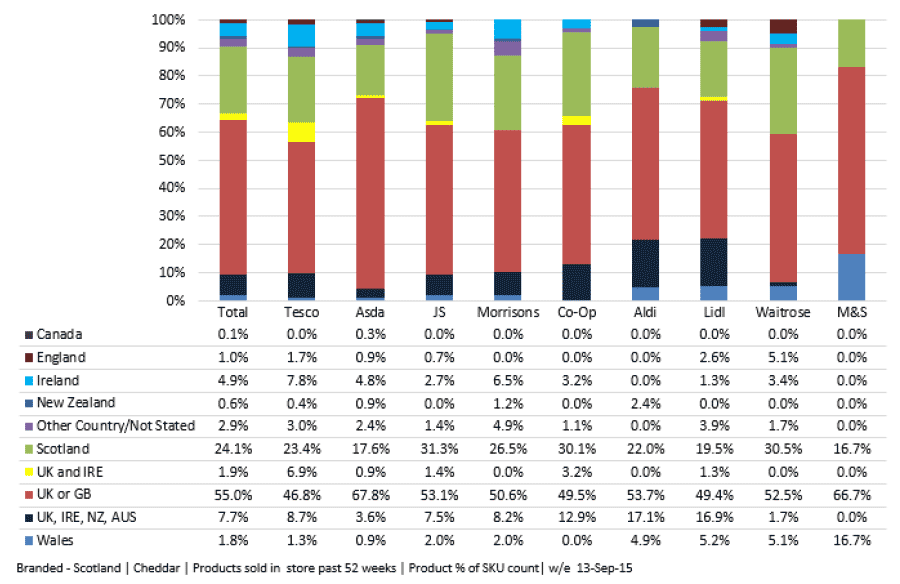
Contact
There is a problem
Thanks for your feedback